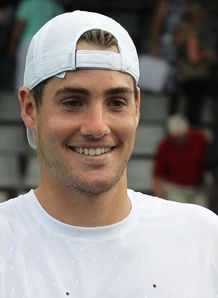 John Isner is a shy guy. He wears his cap, and his head often tilts down, as if he’s embarrassed by the attention he gets. At 6’9″ (and some claim he’s taller than that), Isner is hard to miss. There are few tennis players that he can look eye-to-eye without having to stare down. Perhaps only Ivo Karlovic, the big serving Croatian. Like Karlovic, Isner has a big serve, but unlike Karlovic, Isner has something of a ground game. His shyness contrasts a bit with relative good looks. It’s like he wants to be successful without being noticed. It’s hard to catch him without his cap on.
John Isner is a shy guy. He wears his cap, and his head often tilts down, as if he’s embarrassed by the attention he gets. At 6’9″ (and some claim he’s taller than that), Isner is hard to miss. There are few tennis players that he can look eye-to-eye without having to stare down. Perhaps only Ivo Karlovic, the big serving Croatian. Like Karlovic, Isner has a big serve, but unlike Karlovic, Isner has something of a ground game. His shyness contrasts a bit with relative good looks. It’s like he wants to be successful without being noticed. It’s hard to catch him without his cap on.
Isner took the college route to the pros. This is an unusual route. Typically, great tennis players mature early. They are winning at 17 and 18 and serving notice. At 21, they have the look of a grizzled veteran. Names like Nadal, Djokovic and Murray are the kind of guys that mature early and contend for Slams.
To go to college is to admit that your game isn’t ready for prime time, at least, of the wunderkind sort. The game has changed enough that players that are older are finding success. Radek Stepanek is 31 and is perhaps playing his best tennis. Ivo Karlovic, just mentioned, is 30 years old and is serving as well as ever. Perhaps his huge serve may serve as inspiration. Andy Murray relies on his foot speed to win matches, but at age 22 still is young. As he gets older, Andy may discover that history shows that power players have longevity. Tommy Haas is still doing well above the age of 30. So John Isner, 24 years of age, has some hope that although he took the college route, he can continue an upward rise, at least comparable to his stature.
Isner played at the University of Georgia. Born in North Carolina, there was probably some who felt he picked the wrong sport. Surely a man of his height should play basketball. Perhaps like the more gregarious and similarly tall Sam Querrey, he found solace in the solo aspect of tennis. Isner probably doesn’t like the idea of dealing with so many people in basketball. Little did he know that he wouldn’t be a novelty in tennis, that height was the flavor du jour. del Potro, Berdych, Querrey, Cilic, Karlovic–all these players are showing that height in tennis is valuable.
This goes against the conventional wisdom of tennis. Back in the first heyday of tennis, the 1970s, the top male pros, Connors, Borg, McEnroe, were all under 6 feet tall. Indeed, the top Australians, Laver and Rosewall were even shorter, at 5’7″ or so. Victor Amaya, at 6’5″ was considered a bit of a freak. Anyone that tall, like a 7 footer in the NBA told they must play center, was told to come to net. Follow that big serve into net.
Since then, the trend has gone upwards. Players like Sampras, Edberg, Lendl were all a shade above 6 feet. Ever since players have mastered the power of their big racquets and discovered that a hard hit shot to the corner was still reachable and still an opportunity to hit a pass, serve and volleyers have struggled to win at the top level. People forget that Roger Federer served and volleyed his way to a win over Pete Sampras back in 2001. He had lacked confidence in his ground game that he felt he had to go to net against his top rivals, Lleyton Hewitt and David Nalbandian. Federer made himself into a superb groundstroker and stopped serving and volleying, realizing that would lead him to more losses than wins.
So even a player as big as Isner found that he had to win at the baseline. Isner decided that he needed the two big strokes everyone has: a big serve and a big forehand. You can’t just be a big serve in today’s game. You need something to threaten to break. Although Isner’s movement isn’t as fluid as it could be, he’s harnessed that forehand into a weapon.
He finally reached the first big goal in his life, one that he was close to reaching back in 2007 when he made the finals of the Legg Mason Tennis Classic in Washington DC, when he went to Auckland and reached the finals to face veteran Frenchman, Arnaud Clement, (how do those Frenchies manage to play so long–Santoro wants to unretire at 35!). In a tough 3-setter, Isner has finally won his first title at the Heineken Open in Auckland, with a final score of 6-3, 5-7, 7-6(2). He’ll reach a career high of 28 with this win.
Will this lead to a big Australian Open? He already had a huge upset of Andy Roddick at the US Open. Who knows? But he’ll always be able to look back to Auckland, about as far from home as he could have imagined, and remember his first time.



![[Stockholm] Dimitrov wins first ATP title with 3-set victory over Ferrer](https://www.essentialtennis.com/wp-content/uploads/2013/10/20131021grigor-500x383.jpg)
![[Metz/St. Petersburg] Simon and Gulbis are champions!](https://www.essentialtennis.com/wp-content/uploads/2013/09/20130922gulbis-500x383.jpg)

